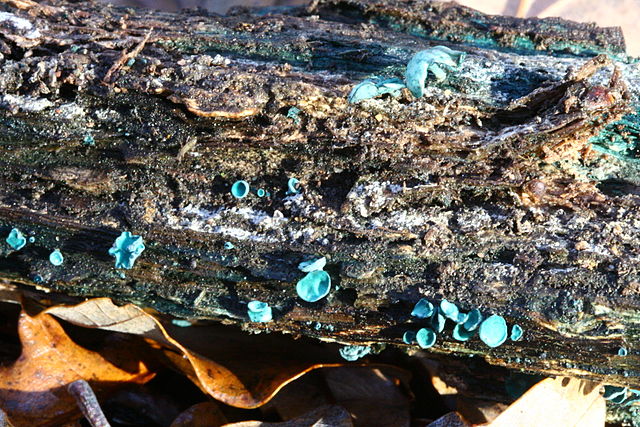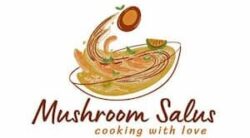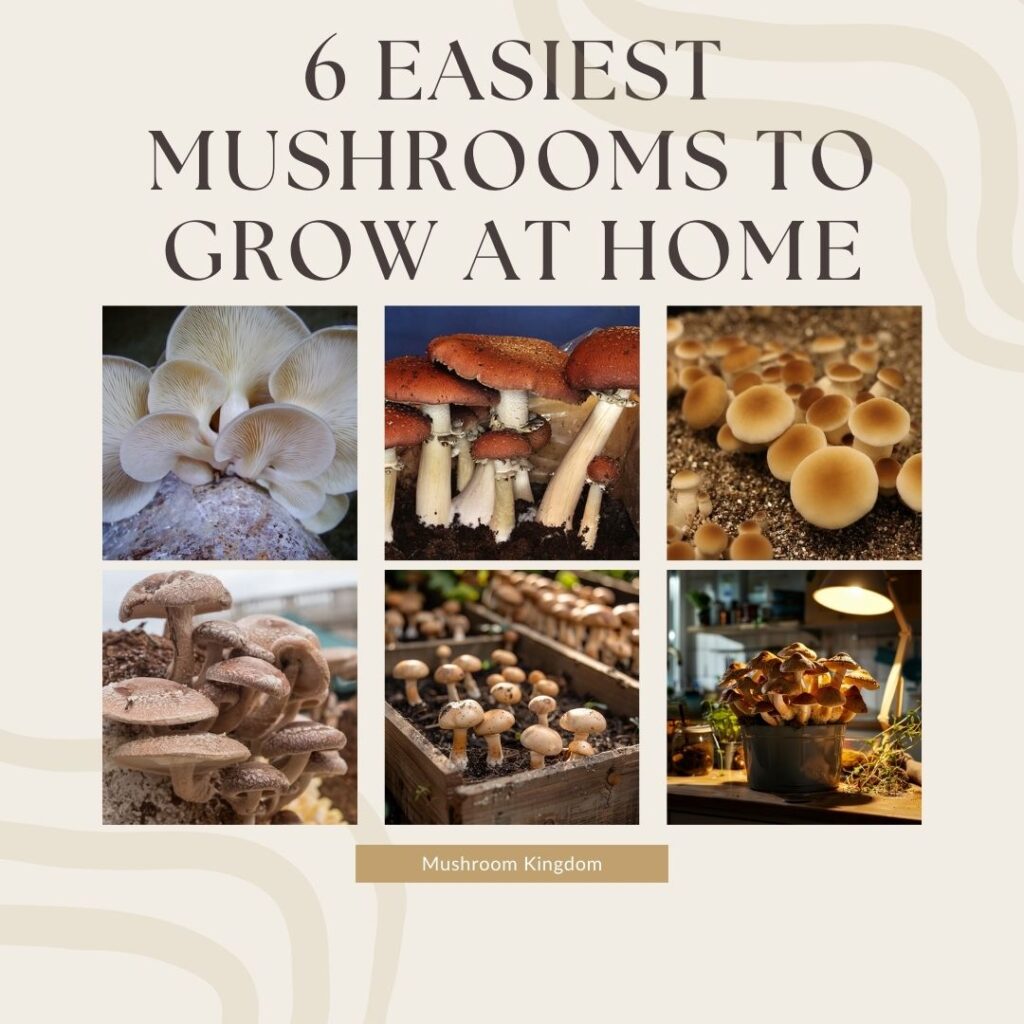Chlorociboria aeruginascens, commonly known as the Green Elfcup, is a fascinating fungus renowned for its vibrant blue-green coloration.
This guide provides essential information for foragers looking to identify and understand this unique species.

What is chlorociboria aeruginascens?
Chlorociboria aeruginascens belongs to the Ascomycota division, which includes fungi characterized by their spore-producing structures known as asci.
The Green Elfcup primarily grows on decaying hardwood, where it imparts a striking blue-green stain to the wood, often used in woodworking for its aesthetic appeal.
Despite its small size, this fungus plays a significant role in forest ecosystems by contributing to the decomposition process.
How to Identify Chlorociboria Aeruginascens?
Identifying Chlorociboria aeruginascens involves observing several distinctive characteristics that set it apart from other fungi.
Here’s a detailed guide to help you recognize this unique species:
Blue-Green Stain on Wood
One of the most prominent features of Chlorociboria aeruginascens is the striking blue-green stain it leaves on decaying hardwood.
This stain is not just on the surface but can penetrate deeply into the wood, creating a vivid, colorful pattern. This stained wood, sometimes referred to as “green oak” or “blue-stained wood,” is highly prized by woodworkers for its decorative value.

Fruiting Bodies
The fruiting bodies, also known as ascomata, are small and delicate. These cup-like structures range from 0.5 to 1.5 centimeters in diameter.
The shape of the fruiting bodies is typically shallow and cup-like, with a slightly wavy margin.
The inner surface of the cup is usually a vibrant blue-green, matching the color of the stain it produces on the wood. The outer surface might be slightly paler but still retains a greenish hue.
Stem
In some specimens, a short, slender stem is present, which is usually of the same blue-green color as the cup.
However, the stem is often minimal or absent, making the cups appear to be directly attached to the wood surface.

Habitat and Growth Pattern
Chlorociboria aeruginascens usually grows on decaying hardwood, particularly favoring trees like oak, beech, and maple.
This fungus often appears in clusters or scattered groups on the wood, which can help in identification.
Look for it on fallen branches, logs, and stumps, where the wood is in an advanced stage of decay but still intact.
Season and Conditions
The Green Elfcup tends to fruit throughout the year, but it is most commonly observed in the fall and after periods of heavy rain, when the moisture levels are ideal for fungal growth.
It prefers humid, shaded environments, which are typical of temperate forests.
Microscopic Features
For those with access to a microscope, the spores of Chlorociboria aeruginascens can provide additional confirmation.
The spores are ellipsoid, smooth, and measure approximately 8–10 micrometers in length. Observing these spores can help distinguish it from other similar-looking fungi.
Use of Tools
To enhance the identification process, foragers should carry a hand lens or magnifying glass.
These tools are essential for closely examining the small fruiting bodies and the detailed structure of the cups and stems.
Bringing a field guide with high-quality photographs and descriptions can also be very useful.
Comparative Identification
It is also helpful to be aware of other fungi that might be confused with Chlorociboria aeruginascens.
For instance, some blue-green molds might stain wood, but they lack the distinctive cup-shaped fruiting bodies. Knowing these differences will sharpen your identification skills.
Is Chlorociboria aeruginascens Edible?
Chlorociboria aeruginascens is not considered edible. Its small size and tough texture make it impractical for culinary use.
Furthermore, there is limited information on its edibility and potential health effects.
Although it is not known to be toxic, consuming unknown fungi is generally discouraged.
Where You Can Find Green Elfcup?
Green Elfcup thrives in temperate forests, particularly in regions with high humidity and ample decaying hardwood. Look for this fungus in North America, Europe, and parts of Asia.
It often colonizes fallen branches, logs, and stumps of hardwood trees such as oak, beech, and maple. Foragers should search in moist, shaded areas of the forest, especially after periods of rain when the fruiting bodies are more likely to appear.
Using a guidebook or joining a local mycology group can help foragers locate specific habitats where Chlorociboria aeruginascens is known to grow.
Is Green Elfcup a Toxic Mushroom?
Green Elfcup is not classified as toxic. However, due to its inedibility and lack of nutritional value, it is best appreciated for its aesthetic qualities rather than consumed.
The fungus’s primary contribution is ecological, aiding in the decomposition of wood and recycling nutrients back into the forest ecosystem.
While it does not pose a threat to humans, always exercise caution and avoid ingesting any wild fungi unless you are absolutely certain of their safety and edibility.
Chlorociboria aeruginascens Etymology Explained
Understanding the etymology of Chlorociboria aeruginascens offers fascinating insights into its scientific naming and the characteristics that influenced it.
Genus: Chlorociboria
The genus name “Chlorociboria” derives from Greek and Latin roots:
- Chloro-: This prefix comes from the Greek word “chloros,” meaning green. It refers to the distinctive blue-green coloration of the fungus, which is one of its most notable features.
- -ciboria: This suffix is derived from the Latin word “ciborium,” which means a cup or drinking vessel. This term relates to the cup-like shape of the fruiting bodies of the fungus.
When combined, “Chlorociboria” essentially means “green cup,” highlighting both the color and the shape of the fungus.
Species: aeruginascens
The species name “aeruginascens” also has Latin roots:
- Aeruginascens: This term is derived from “aerugo,” which means verdigris or copper rust, referring to a greenish-blue patina that forms on copper and bronze surfaces. The suffix “-ascens” means “becoming” or “turning into.”
Thus, “aeruginascens” translates to “becoming greenish-blue” or “turning into verdigris,” which perfectly describes the blue-green staining effect that the fungus has on wood.
Complete Name Interpretation
Putting it all together, “Chlorociboria aeruginascens” can be interpreted as “the green cup that becomes greenish-blue.” This name is a precise and vivid description of the fungus, encapsulating its unique coloration and the cup-like structure of its fruiting bodies. It reflects both the visual impact of the fungus and its scientific classification based on observable traits.
Conclusion
Chlorociboria aeruginascens, or the Green Elfcup, is a unique and visually striking fungus that adds beauty to decaying wood in temperate forests.
Though it is not edible, its vibrant blue-green color makes it a fascinating subject for foragers and nature enthusiasts.
By learning how to identify and locate this fungus, you can gain a deeper appreciation for the diversity and complexity of forest ecosystems.
Remember to respect nature and practice sustainable foraging to ensure the continued presence of these incredible organisms in our forests.


